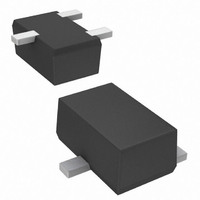2SA1162GT1 ON Semiconductor, 2SA1162GT1 Datasheet - Page 4

2SA1162GT1
Manufacturer Part Number
2SA1162GT1
Description
TRANSISTOR PNP 50V 150MA SC-59
Manufacturer
ON Semiconductor
Datasheet
1.2SA1162GT1.pdf
(6 pages)
Specifications of 2SA1162GT1
Transistor Type
PNP
Current - Collector (ic) (max)
150mA
Voltage - Collector Emitter Breakdown (max)
50V
Vce Saturation (max) @ Ib, Ic
300mV @ 10mA, 100mA
Current - Collector Cutoff (max)
100nA
Dc Current Gain (hfe) (min) @ Ic, Vce
200 @ 2mA, 6V
Power - Max
200mW
Frequency - Transition
80MHz
Mounting Type
Surface Mount
Package / Case
SC-59-3, SMT3, SOT-346, TO-236
Lead Free Status / RoHS Status
Contains lead / RoHS non-compliant
circuit board, solder paste must be applied to the pads. A
solder stencil is required to screen the optimum amount of
solder paste onto the footprint. The stencil is made of brass
or stainless steel with a typical thickness of 0.008 inches.
trol settings that will give the desired heat pattern. The op-
erator must set temperatures for several heating zones, and
a figure for belt speed. Taken together, these control set-
tings make up a heating “profile” for that particular circuit
board. On machines controlled by a computer, the comput-
er remembers these profiles from one operating session to
the next. Figure 1 shows a typical heating profile for use
when soldering a surface mount device to a printed circuit
board. This profile will vary among soldering systems but
it is a good starting point. Factors that can affect the profile
include the type of soldering system in use, density and
types of components on the board, type of solder used, and
the type of board or substrate material being used. This pro-
file
Prior to placing surface mount components onto a printed
For any given circuit board, there will be a group of con-
shows
temperature
200 C
150 C
100 C
50 C
PREHEAT
ZONE 1
STEP 1
TIME (3 TO 7 MINUTES TOTAL)
RAMP"
DESIRED CURVE FOR HIGH
MASS ASSEMBLIES
TYPICAL SOLDER HEATING PROFILE
versus
STEP 2
SOLDER STENCIL GUIDELINES
VENT
SOAK"
150 C
100 C
2SA1162GT1, 2SA1162YT1
Figure 1. Typical Solder Heating Profile
ZONES 2 & 5
DESIRED CURVE FOR LOW
HEATING
STEP 3
http://onsemi.com
RAMP"
time.
MASS ASSEMBLIES
160 C
4
ZONES 3 & 6
140 C
HEATING
The line on the graph shows the actual temperature that
might be experienced on the surface of a test board at or
near a central solder joint. The two profiles are based on a
high density and a low density board. The Vitronics
SMD310 convection/infrared reflow soldering system was
used to generate this profile. The type of solder used was
62/36/2 Tin Lead Silver with a melting point between
177−189 C. When this type of furnace is used for solder re-
flow work, the circuit boards and solder joints tend to heat
first. The components on the board are then heated by con-
duction. The circuit board, because it has a large surface
area, absorbs the thermal energy more efficiently, then dis-
tributes this energy to the components. Because of this ef-
fect, the main body of a component may be up to 30 degrees
cooler than the adjacent solder joints.
STEP 4
The stencil opening size for the surface mounted package
should be the same as the pad size on the printed circuit
board, i.e., a 1:1 registration.
SOAK"
SOLDER IS LIQUID FOR
MASS OF ASSEMBLY)
170 C
40 TO 80 SECONDS
ZONES 4 & 7
(DEPENDING ON
HEATING
STEP 5
SPIKE"
T
MAX
STEP 6
VENT
SOLDER JOINT
205 TO 219 C
COOLING
PEAK AT
STEP 7





